Sociology Assignment: Health, Politics, and Amata Community
VerifiedAdded on 2022/08/20
|6
|1296
|50
Essay
AI Summary
This sociology assignment examines the health disparities within the Amata community, an Indigenous population residing in southern Australia. The essay highlights that the Amata community experiences poorer health outcomes, including higher infant mortality and prevalence of diseases, compared to non-Indigenous Australians. It explores the social determinants of health, such as poverty, lack of education, and language barriers, as significant contributors to these disparities. The assignment further discusses the impact of political determinants, including government policies and legislative failures, on the community's health, emphasizing the denial of human rights and inequitable resource allocation. The essay references various studies to support its claims and suggests the need for a socio-cultural approach and comprehensive health strategies involving the Amata community to address these inequalities and improve health outcomes. The assignment concludes by emphasizing the need for holistic approaches to address the social determinants of health and develop strategies that consider the Amata community's participation.
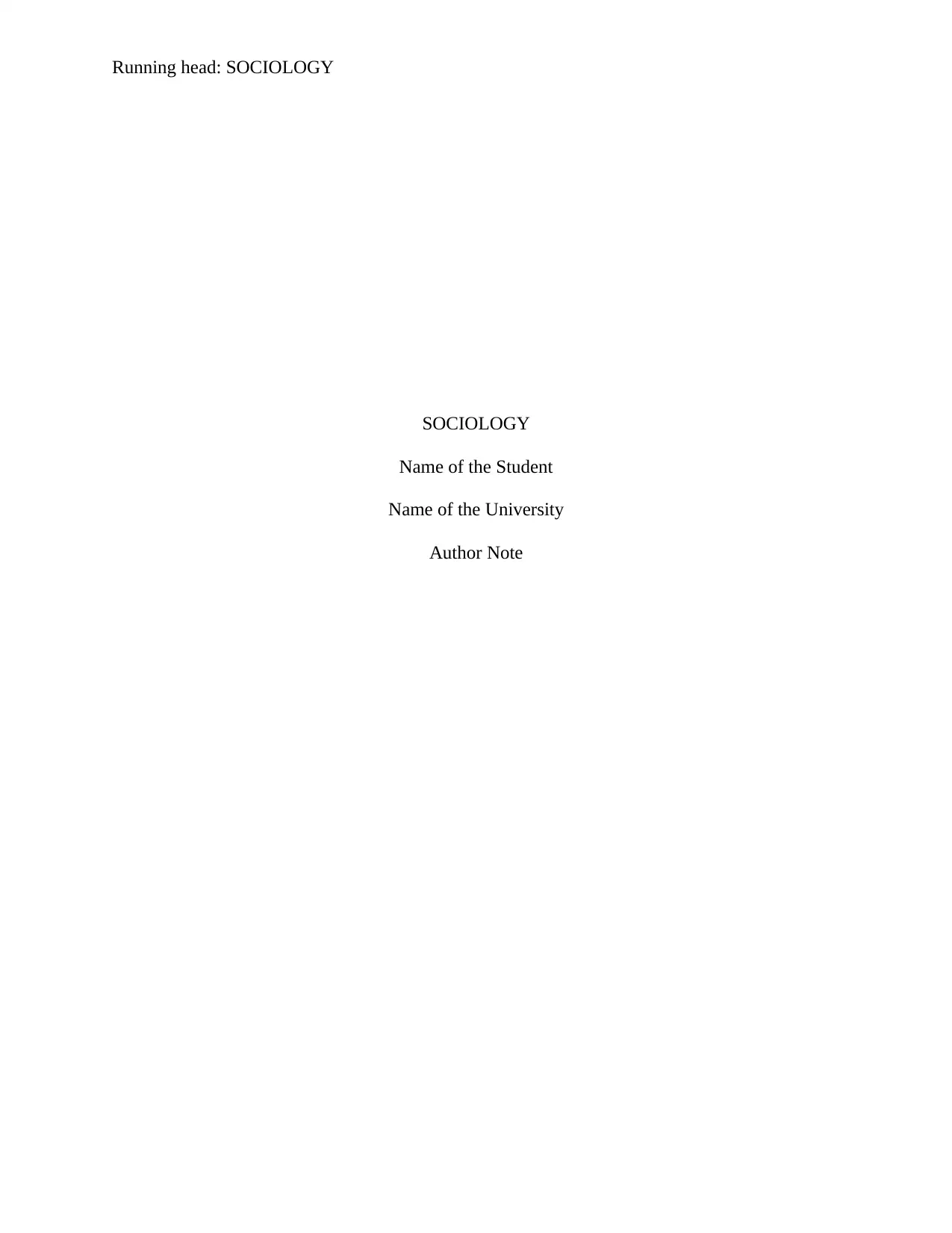
Running head: SOCIOLOGY
SOCIOLOGY
Name of the Student
Name of the University
Author Note
SOCIOLOGY
Name of the Student
Name of the University
Author Note
Paraphrase This Document
Need a fresh take? Get an instant paraphrase of this document with our AI Paraphraser
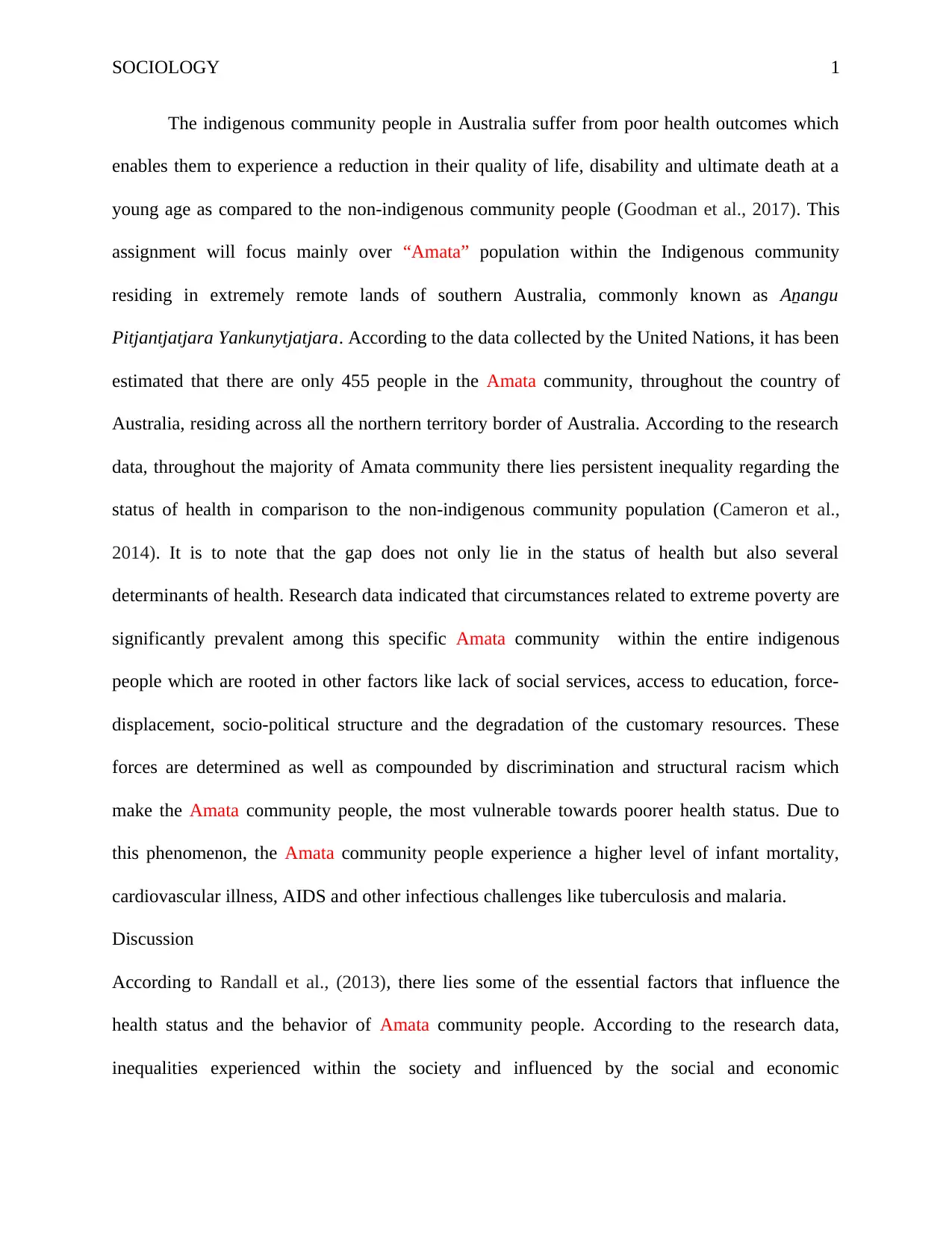
SOCIOLOGY 1
The indigenous community people in Australia suffer from poor health outcomes which
enables them to experience a reduction in their quality of life, disability and ultimate death at a
young age as compared to the non-indigenous community people (Goodman et al., 2017). This
assignment will focus mainly over “Amata” population within the Indigenous community
residing in extremely remote lands of southern Australia, commonly known as Aṉangu
Pitjantjatjara Yankunytjatjara. According to the data collected by the United Nations, it has been
estimated that there are only 455 people in the Amata community, throughout the country of
Australia, residing across all the northern territory border of Australia. According to the research
data, throughout the majority of Amata community there lies persistent inequality regarding the
status of health in comparison to the non-indigenous community population (Cameron et al.,
2014). It is to note that the gap does not only lie in the status of health but also several
determinants of health. Research data indicated that circumstances related to extreme poverty are
significantly prevalent among this specific Amata community within the entire indigenous
people which are rooted in other factors like lack of social services, access to education, force-
displacement, socio-political structure and the degradation of the customary resources. These
forces are determined as well as compounded by discrimination and structural racism which
make the Amata community people, the most vulnerable towards poorer health status. Due to
this phenomenon, the Amata community people experience a higher level of infant mortality,
cardiovascular illness, AIDS and other infectious challenges like tuberculosis and malaria.
Discussion
According to Randall et al., (2013), there lies some of the essential factors that influence the
health status and the behavior of Amata community people. According to the research data,
inequalities experienced within the society and influenced by the social and economic
The indigenous community people in Australia suffer from poor health outcomes which
enables them to experience a reduction in their quality of life, disability and ultimate death at a
young age as compared to the non-indigenous community people (Goodman et al., 2017). This
assignment will focus mainly over “Amata” population within the Indigenous community
residing in extremely remote lands of southern Australia, commonly known as Aṉangu
Pitjantjatjara Yankunytjatjara. According to the data collected by the United Nations, it has been
estimated that there are only 455 people in the Amata community, throughout the country of
Australia, residing across all the northern territory border of Australia. According to the research
data, throughout the majority of Amata community there lies persistent inequality regarding the
status of health in comparison to the non-indigenous community population (Cameron et al.,
2014). It is to note that the gap does not only lie in the status of health but also several
determinants of health. Research data indicated that circumstances related to extreme poverty are
significantly prevalent among this specific Amata community within the entire indigenous
people which are rooted in other factors like lack of social services, access to education, force-
displacement, socio-political structure and the degradation of the customary resources. These
forces are determined as well as compounded by discrimination and structural racism which
make the Amata community people, the most vulnerable towards poorer health status. Due to
this phenomenon, the Amata community people experience a higher level of infant mortality,
cardiovascular illness, AIDS and other infectious challenges like tuberculosis and malaria.
Discussion
According to Randall et al., (2013), there lies some of the essential factors that influence the
health status and the behavior of Amata community people. According to the research data,
inequalities experienced within the society and influenced by the social and economic
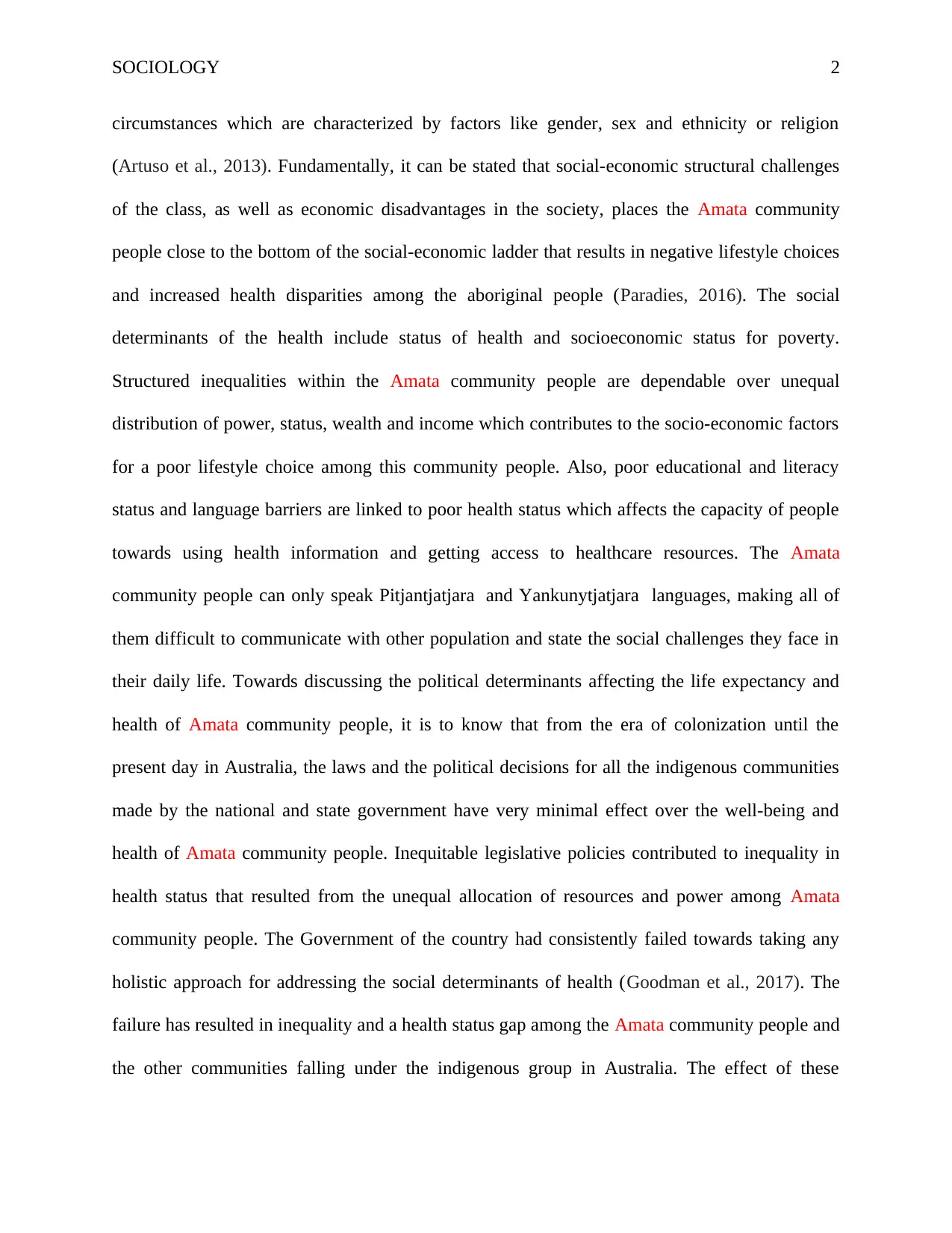
SOCIOLOGY 2
circumstances which are characterized by factors like gender, sex and ethnicity or religion
(Artuso et al., 2013). Fundamentally, it can be stated that social-economic structural challenges
of the class, as well as economic disadvantages in the society, places the Amata community
people close to the bottom of the social-economic ladder that results in negative lifestyle choices
and increased health disparities among the aboriginal people (Paradies, 2016). The social
determinants of the health include status of health and socioeconomic status for poverty.
Structured inequalities within the Amata community people are dependable over unequal
distribution of power, status, wealth and income which contributes to the socio-economic factors
for a poor lifestyle choice among this community people. Also, poor educational and literacy
status and language barriers are linked to poor health status which affects the capacity of people
towards using health information and getting access to healthcare resources. The Amata
community people can only speak Pitjantjatjara and Yankunytjatjara languages, making all of
them difficult to communicate with other population and state the social challenges they face in
their daily life. Towards discussing the political determinants affecting the life expectancy and
health of Amata community people, it is to know that from the era of colonization until the
present day in Australia, the laws and the political decisions for all the indigenous communities
made by the national and state government have very minimal effect over the well-being and
health of Amata community people. Inequitable legislative policies contributed to inequality in
health status that resulted from the unequal allocation of resources and power among Amata
community people. The Government of the country had consistently failed towards taking any
holistic approach for addressing the social determinants of health (Goodman et al., 2017). The
failure has resulted in inequality and a health status gap among the Amata community people and
the other communities falling under the indigenous group in Australia. The effect of these
circumstances which are characterized by factors like gender, sex and ethnicity or religion
(Artuso et al., 2013). Fundamentally, it can be stated that social-economic structural challenges
of the class, as well as economic disadvantages in the society, places the Amata community
people close to the bottom of the social-economic ladder that results in negative lifestyle choices
and increased health disparities among the aboriginal people (Paradies, 2016). The social
determinants of the health include status of health and socioeconomic status for poverty.
Structured inequalities within the Amata community people are dependable over unequal
distribution of power, status, wealth and income which contributes to the socio-economic factors
for a poor lifestyle choice among this community people. Also, poor educational and literacy
status and language barriers are linked to poor health status which affects the capacity of people
towards using health information and getting access to healthcare resources. The Amata
community people can only speak Pitjantjatjara and Yankunytjatjara languages, making all of
them difficult to communicate with other population and state the social challenges they face in
their daily life. Towards discussing the political determinants affecting the life expectancy and
health of Amata community people, it is to know that from the era of colonization until the
present day in Australia, the laws and the political decisions for all the indigenous communities
made by the national and state government have very minimal effect over the well-being and
health of Amata community people. Inequitable legislative policies contributed to inequality in
health status that resulted from the unequal allocation of resources and power among Amata
community people. The Government of the country had consistently failed towards taking any
holistic approach for addressing the social determinants of health (Goodman et al., 2017). The
failure has resulted in inequality and a health status gap among the Amata community people and
the other communities falling under the indigenous group in Australia. The effect of these
⊘ This is a preview!⊘
Do you want full access?
Subscribe today to unlock all pages.

Trusted by 1+ million students worldwide
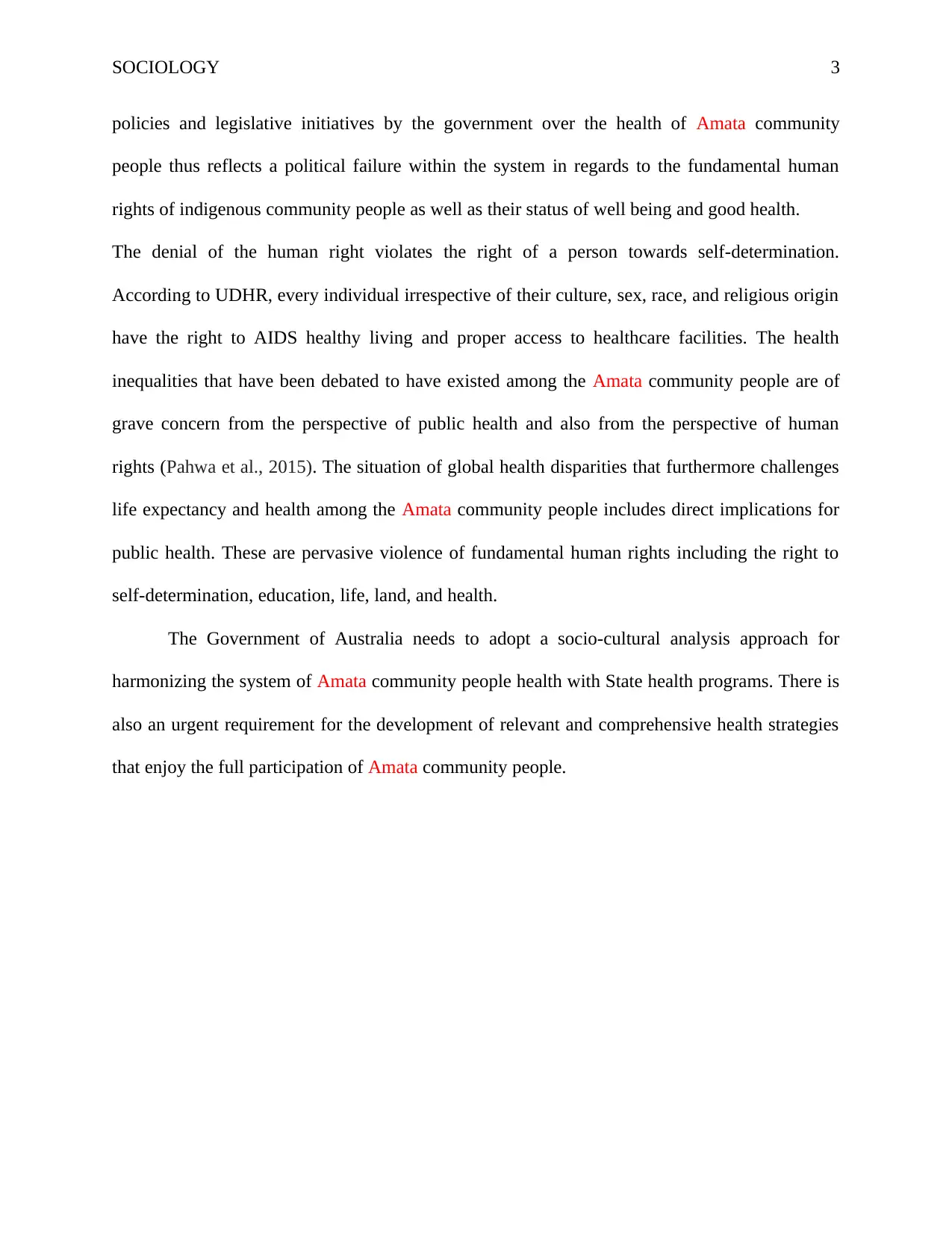
SOCIOLOGY 3
policies and legislative initiatives by the government over the health of Amata community
people thus reflects a political failure within the system in regards to the fundamental human
rights of indigenous community people as well as their status of well being and good health.
The denial of the human right violates the right of a person towards self-determination.
According to UDHR, every individual irrespective of their culture, sex, race, and religious origin
have the right to AIDS healthy living and proper access to healthcare facilities. The health
inequalities that have been debated to have existed among the Amata community people are of
grave concern from the perspective of public health and also from the perspective of human
rights (Pahwa et al., 2015). The situation of global health disparities that furthermore challenges
life expectancy and health among the Amata community people includes direct implications for
public health. These are pervasive violence of fundamental human rights including the right to
self-determination, education, life, land, and health.
The Government of Australia needs to adopt a socio-cultural analysis approach for
harmonizing the system of Amata community people health with State health programs. There is
also an urgent requirement for the development of relevant and comprehensive health strategies
that enjoy the full participation of Amata community people.
policies and legislative initiatives by the government over the health of Amata community
people thus reflects a political failure within the system in regards to the fundamental human
rights of indigenous community people as well as their status of well being and good health.
The denial of the human right violates the right of a person towards self-determination.
According to UDHR, every individual irrespective of their culture, sex, race, and religious origin
have the right to AIDS healthy living and proper access to healthcare facilities. The health
inequalities that have been debated to have existed among the Amata community people are of
grave concern from the perspective of public health and also from the perspective of human
rights (Pahwa et al., 2015). The situation of global health disparities that furthermore challenges
life expectancy and health among the Amata community people includes direct implications for
public health. These are pervasive violence of fundamental human rights including the right to
self-determination, education, life, land, and health.
The Government of Australia needs to adopt a socio-cultural analysis approach for
harmonizing the system of Amata community people health with State health programs. There is
also an urgent requirement for the development of relevant and comprehensive health strategies
that enjoy the full participation of Amata community people.
Paraphrase This Document
Need a fresh take? Get an instant paraphrase of this document with our AI Paraphraser
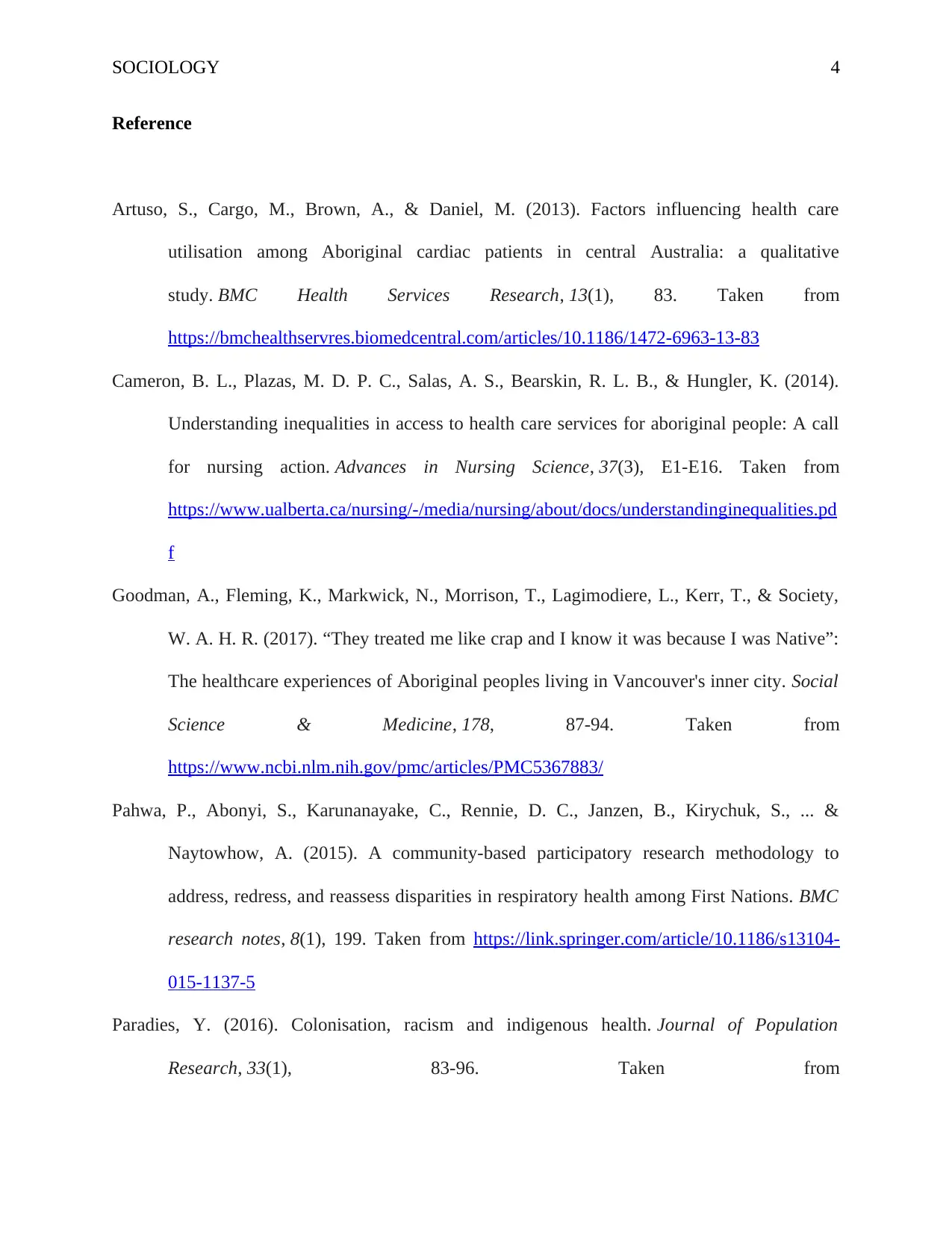
SOCIOLOGY 4
Reference
Artuso, S., Cargo, M., Brown, A., & Daniel, M. (2013). Factors influencing health care
utilisation among Aboriginal cardiac patients in central Australia: a qualitative
study. BMC Health Services Research, 13(1), 83. Taken from
https://bmchealthservres.biomedcentral.com/articles/10.1186/1472-6963-13-83
Cameron, B. L., Plazas, M. D. P. C., Salas, A. S., Bearskin, R. L. B., & Hungler, K. (2014).
Understanding inequalities in access to health care services for aboriginal people: A call
for nursing action. Advances in Nursing Science, 37(3), E1-E16. Taken from
https://www.ualberta.ca/nursing/-/media/nursing/about/docs/understandinginequalities.pd
f
Goodman, A., Fleming, K., Markwick, N., Morrison, T., Lagimodiere, L., Kerr, T., & Society,
W. A. H. R. (2017). “They treated me like crap and I know it was because I was Native”:
The healthcare experiences of Aboriginal peoples living in Vancouver's inner city. Social
Science & Medicine, 178, 87-94. Taken from
https://www.ncbi.nlm.nih.gov/pmc/articles/PMC5367883/
Pahwa, P., Abonyi, S., Karunanayake, C., Rennie, D. C., Janzen, B., Kirychuk, S., ... &
Naytowhow, A. (2015). A community-based participatory research methodology to
address, redress, and reassess disparities in respiratory health among First Nations. BMC
research notes, 8(1), 199. Taken from https://link.springer.com/article/10.1186/s13104-
015-1137-5
Paradies, Y. (2016). Colonisation, racism and indigenous health. Journal of Population
Research, 33(1), 83-96. Taken from
Reference
Artuso, S., Cargo, M., Brown, A., & Daniel, M. (2013). Factors influencing health care
utilisation among Aboriginal cardiac patients in central Australia: a qualitative
study. BMC Health Services Research, 13(1), 83. Taken from
https://bmchealthservres.biomedcentral.com/articles/10.1186/1472-6963-13-83
Cameron, B. L., Plazas, M. D. P. C., Salas, A. S., Bearskin, R. L. B., & Hungler, K. (2014).
Understanding inequalities in access to health care services for aboriginal people: A call
for nursing action. Advances in Nursing Science, 37(3), E1-E16. Taken from
https://www.ualberta.ca/nursing/-/media/nursing/about/docs/understandinginequalities.pd
f
Goodman, A., Fleming, K., Markwick, N., Morrison, T., Lagimodiere, L., Kerr, T., & Society,
W. A. H. R. (2017). “They treated me like crap and I know it was because I was Native”:
The healthcare experiences of Aboriginal peoples living in Vancouver's inner city. Social
Science & Medicine, 178, 87-94. Taken from
https://www.ncbi.nlm.nih.gov/pmc/articles/PMC5367883/
Pahwa, P., Abonyi, S., Karunanayake, C., Rennie, D. C., Janzen, B., Kirychuk, S., ... &
Naytowhow, A. (2015). A community-based participatory research methodology to
address, redress, and reassess disparities in respiratory health among First Nations. BMC
research notes, 8(1), 199. Taken from https://link.springer.com/article/10.1186/s13104-
015-1137-5
Paradies, Y. (2016). Colonisation, racism and indigenous health. Journal of Population
Research, 33(1), 83-96. Taken from
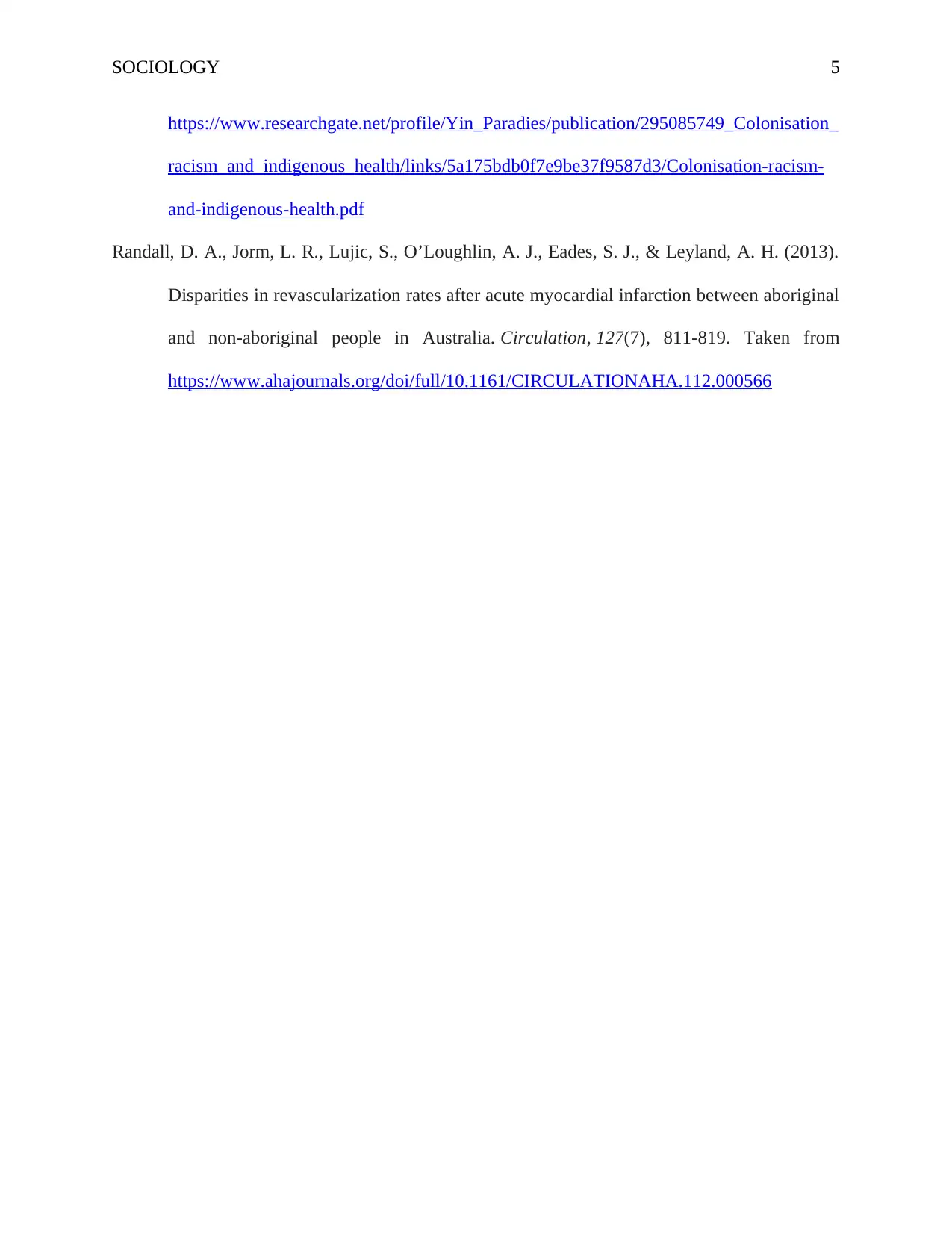
SOCIOLOGY 5
https://www.researchgate.net/profile/Yin_Paradies/publication/295085749_Colonisation_
racism_and_indigenous_health/links/5a175bdb0f7e9be37f9587d3/Colonisation-racism-
and-indigenous-health.pdf
Randall, D. A., Jorm, L. R., Lujic, S., O’Loughlin, A. J., Eades, S. J., & Leyland, A. H. (2013).
Disparities in revascularization rates after acute myocardial infarction between aboriginal
and non-aboriginal people in Australia. Circulation, 127(7), 811-819. Taken from
https://www.ahajournals.org/doi/full/10.1161/CIRCULATIONAHA.112.000566
https://www.researchgate.net/profile/Yin_Paradies/publication/295085749_Colonisation_
racism_and_indigenous_health/links/5a175bdb0f7e9be37f9587d3/Colonisation-racism-
and-indigenous-health.pdf
Randall, D. A., Jorm, L. R., Lujic, S., O’Loughlin, A. J., Eades, S. J., & Leyland, A. H. (2013).
Disparities in revascularization rates after acute myocardial infarction between aboriginal
and non-aboriginal people in Australia. Circulation, 127(7), 811-819. Taken from
https://www.ahajournals.org/doi/full/10.1161/CIRCULATIONAHA.112.000566
⊘ This is a preview!⊘
Do you want full access?
Subscribe today to unlock all pages.

Trusted by 1+ million students worldwide
1 out of 6
Related Documents
Your All-in-One AI-Powered Toolkit for Academic Success.
+13062052269
info@desklib.com
Available 24*7 on WhatsApp / Email
![[object Object]](/_next/static/media/star-bottom.7253800d.svg)
Unlock your academic potential
Copyright © 2020–2025 A2Z Services. All Rights Reserved. Developed and managed by ZUCOL.





